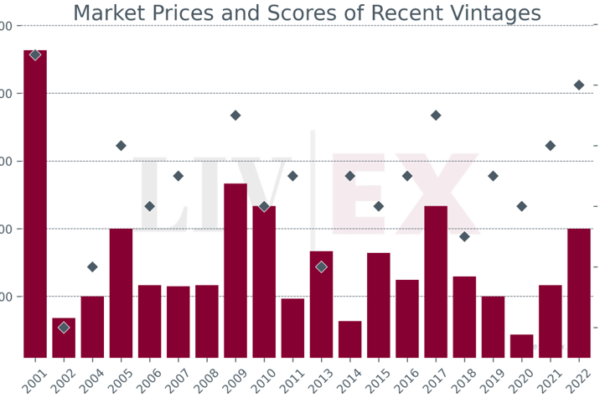Guest blog from Gavin Quinney
Liv-ex is opening the blog once again to Gavin Quinney (@GavinQuinney), a local grower and winemaker, for an insider's view on the wines of 2010. This report follows on from his analysis of the weather during the 2010 growing season and harvest.
—
There’s an embarrassment of riches in the best barrel cellars of Bordeaux right now. The relatively inexpensive 2008s are being shipped out (the first tranche offer of 100€ ex-cellars for First Growths in April 2009 seems a long time ago), leaving row upon row of French oak barriques bearing the precious, pre-paid 2009 vintage. And, currently being assembled in the ‘first year’ cellars, there’s another great vintage waiting in line.
Time will tell if Lilian Barton Sartorius was right when she said at the start of the harvest, “However well the 2010s turn out, they are going to be cheaper than the 2009s.” At the time I nodded sagely in agreement, but now, following an outstanding harvest and with more names being touted as the next big thing in China, I’m not so sure. Meanwhile, a few wise old heads are keeping shtum about 2010 as they want their wines to do the talking in the spring. Nobody wants to hear about another vintage of the century. At least, not just yet.
After concerns that he would be unable to travel following knee surgery, Robert Parker has indicated that he will be coming to taste the new vintage next month. Significantly, his friend Michel Rolland, the renowned consultant oenologist, believes that most estates that he works with have made, er, better wines in 2010 than in 2009. And for those who prefer wines at the other end of the structure spectrum, Denis Dubourdieu quietly agrees – for reds and dry whites anyway.
I tasted the 2009s again recently at many of the top estates on the Left Bank, and if 2010 is at the same quality level as 2009, it’s a hard act to follow. The 2009s are exuberant, opulent and delicious to taste even now, but what of the other side of the cellar of l’embarras des richesses – the 2010s? The 2010s appear to be more classically Bordeaux-like, but with tremendous power and intensity. I’d call them über-classic, for want of a better expression. The buzz word for the 2009s at this same stage last year was ‘exceptional’ – see my 2009 harvest report. We’ll probably hear a lot more of ‘classic’, ‘intense’, extraordinary’ and ‘balanced’ in reference to 2010.
Jean Guillaume Prats of Cos d’Estournel explains: “Speaking for Cos and not for the others in the Medoc, the 2010 is in the same league as the 2009 but in a completely opposite and different style. 2010 is an extraordinary classic Medoc vintage. A year of drought, of course, and the driest in the last ten years, but nothing like 2003 when there was exposure to so much heat. It was a late vintage and rain on the 4th October in the north of the Medoc helped the Cabernet Sauvignon to extraordinary phenolic ripeness. Beautiful weather followed for picking the Cabernet.”
Jean René Matignon, the technical director of Pichon Baron, agrees, summing up 2010 as ‘un grand millésime de garde par excellence’. He believes yields are generally around ten per cent lower than in 2009 around Pauillac (i.e. in St-Julien and St-Estephe also), in part due to poor flowering in older Merlot vines, as well as smaller berries with less juice from the near-drought conditions. Lilian Barton told me that they only made four tanks of Merlot, compared to six the previous year, for the same reason. The quality of the Merlot, though, is ‘magnifique’, according to Matignon, whose final blend will be 77 per cent Cabernet Sauvignon and 23 per cent Merlot – compared to 67 per cent and 33 per cent in 2009. That’s a significant shift, and if that doesn’t suggest a wine for longer ageing, then the near-record levels of tannin, however ripe, certainly do.
There will undoubtedly be concerns, as in 2009, over the high levels of alcohol on both banks – especially for the Merlot, so it’s a bigger issue on the Right Bank. What is noticeable, though, is the higher acidity than in 2009, giving the wines freshness and balance. The 2010s are very deeply coloured, which is no surprise given the dry conditions and levels of concentration. (I wouldn’t be surprised if some malolactic fermentations struggle to be complete in time for Parker’s visit.)
Steve Blais, who works with Michel Rolland and has clients around the world, believes that 2010 – being a later harvest than 2009 – plays to the strengths of Bordeaux. He works with Malescot St-Exupery in Margaux and many chateaux in Pomerol and St-Emilion.
“It works best here when there’s a slow, even maturity of the grapes. In theory, not too hot and longer is good, but the problem with later vintages is that we get autumn rain. The weather we had over the harvest in 2010 was almost perfect, so we could wait.
“Maybe we’ll see that some estates have terroirs that were just too dry, but many chateaux, like those with clay over limestone, should have made great wines. The 2010s have lower PH (higher acidity), less jammy fruit and incredible freshness. The more samples we taste in the lab, the better I think it is than 2009. Sorry, but it’s true. Don’t forget the vineyards that ripen later either – I have clients in places like Blaye where the wines are tasting extremely good.”
This is the clear message from many of the 'lesser' appellations. Yorick Lavaud, who sources the wine for Rothschild's Mouton Cadet brand and manages 1,200 hectares of vines, was adamant that 2010 is a better vintage than 2009, especially for Merlot.

Mouton Rothschild, 13th Oct 2010
2010 is also an excellent vintage for dry whites and for Sauternes, so if you’re planning on coming to the April trade tastings, make sure you fit them in to your schedule. On that note, I’d suggest you don’t try to cram too much in, too quickly. There’s a lot to take in, and the wines will be quite demanding.
Let’s hope the proprietors aren’t.





